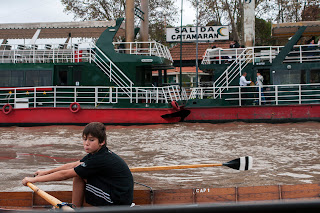The opportunity to visit an
artist’s studio – or in this case, the artist’s apartment – is truly
unique. The way one usually experiences
the work of an artist is on the walls of a gallery or museum; however, when visiting
with an artist on a more personal level, one is privileged to relate more
closely with the artist and his/her work.
In the case of Martin Weber, the personal experience of sitting around
his viewing table as casually listening and looking on as he flipped through
his prints was all too appropriate.
Given the personal nature of his subject matter, the personal setting of
his apartment was a wonderful place to experience his photographs. Spending most of our time flipping through
boxes of prints from a project called A
Map of Latin American Dreams, we got a detailed account of the subjects in
each of the images. Martin’s project
explores the goals and desires of his sitters, the intimate and personal
desires of people we do not even know.
What is interesting is, after hearing Weber tell us what each blackboard
scribbled dream and desire said, he would give a little anecdote about his
experience photographing. This gave the
project a whole other layer that allowed for us, the viewers, to feel slightly
connected to the people in the photograph, regardless of the cultural
differences or the fact that we have never and probably will never meet those
people ever. The thread that ties us to
them and them to one another, though, is their desires – the fact that we all
have goals and dreams that we wish to be fulfilled. Some are simpler than others but we have them
all the same and that link connects us in a way they would not be possible
without Martin’s work.
The second body of work that I
chose to focus on, was titled, Momentos. This project drew inspiration from the
artist’s Argentine background and history.
It deals predominantly with an allusion to the past – a nostalgic
recollection of a different time. Martin
incorporates preexisting photos and images that allude to what the artist describes
as, “the ingenuity and tenderness, power and cruelty, fear and solemnity that
accompanied a slew of memories and signs that filled my childhood.” The photographs comment on memory and the
some things are carried with us for our entire lives, from the time of
childhood. The series is politically
charged and deals with themes of some of Argentina’s darker history. I am no authority, but – from what I can tell
– there is something genuinely Argentine about this body of work that allows
for the photos to seem like snapshots from a different time. Martin’s work is very emotional and
successfully conveys all of that emotion through the care and attention to
technical detail in his prints.















































